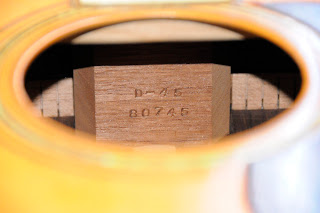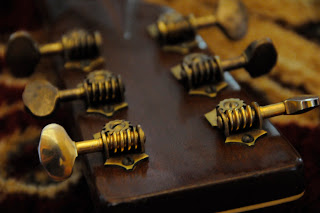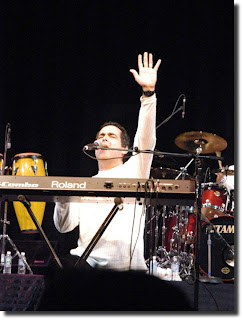I recently had the rare
privilege of being witness to the discovery and re-emergence of a pre-war
Martin D-45, and its subsequent sale. The guitar is one of only 91 D-45s built
by Martin before the model was discontinued due to the demands and limitations
of a nation at war on two fronts in 1942. Subsequently, the D-45 has become the
most sought after, and highly valued acoustic guitar in the world.
This is how the story began,
back in late May of 2011, with a listing on eBay:
“Up for sale is an authentic
Martin pre-war D-45. The 1942 Martin D-45 is well known as the Holy Grail of
acoustic guitars. This guitar has been authenticated by George Gruhn of
Nashville, a well known authority on these rare pre-war Martins. He described
it as being in, “Exceptionally fine original condition”. It has also been
authenticated and inspected by Joe Glaser, a Martin historian and master
luthier. He is one of the leading authorities on WWII era Martins. The 1942
Martin D-45 is admittedly the rarest and most highly prized steel string guitar
in existence. Only 91 were produced from 1933 to 1942. This is one of 12
produced in 1942 and it is in extremely fine original condition. I am listing
this for a friend who wants to remain anonymous.”
“This guitar was bought in
1942 by my grandfather. His hobby was string instruments and he played in a
band for tips. My grandmother was not at all happy when he came home with this
guitar because it was a very expensive guitar, even by 1942 standards. As a
matter of fact, she was not at all happy for several days. He was able to keep
it and played, it in his band. He passed 10 years ago and this guitar has
been in a closet ever since. Recently we got it out and realized what it was,
so we took it and had it appraised. It appraised within the last week for
$375,000. This could be your last chance to ever own one of these, especially
one in this condition. We have had other offers and we have deals in the works
to purchase this guitar. We reserve the right close this auction at any time if
one of the other deals works out. Attached is the copy of the appraisal and
several pictures. E-mail me with any questions and I will get them answered as
soon as I can. The buyer will deal with the owner of this item directly.
The winning bidder will pay a $50,000 deposit in the PayPal account. The rest
will be paid at delivery. Good luck!”
I have held this guitar, and
it is absolutely gorgeous. Its Brazilian rosewood back and sides are
beautifully bookmatched, and the guitar’s incredible abalone inlays along the
top, back, sides, around the edge of the fingerboard, the soundhole, the neck
heel, and the butt (by the endpin) are the result of endless hours of handicraft
performed by Martin’s artisans. The headstock is adorned with a vertical C.F.
Martin logo in mother of pearl. The hexagonal pearl fret marker inlays are
offset remarkably by the ebony fingerboard. Every inlay on this particular
instrument is in outstanding condition – truly stunning. The Adirondack red
spruce top is unmarred, and in magnificent shape.
The guitar’s serial number is
80745, and coincidentally, it is the only pre-war D-45 with a serial number
that ends in 45. It is, as George Gruhn states in his appraisal, ‘in
exceptionally fine original condition.’ The only alterations are a replaced end
pin, and a shaved bridge saddle.
Gary Dick, one of the world’s
foremost authorities on fine vintage instruments, is the dealer who ended up
buying the guitar. He has operated Gary’s Classic Guitars since leaving the
corporate world behind in 1993 to dedicate his efforts to merchandising the
absolute finest in vintage and rare guitars for musicians, collectors, and
investors from around the world. His inventory is an incredible walk through
the history of the guitar – the best pieces, in the best of shape. Every guitar
is in top flight condition, and plays like a dream, even the notoriously
difficult Gretsch and Mosrite guitars play incredibly well – I’ll credit this
to Gary’s attention to detail, and his full time luthier.
When Peter Frampton lost some
of his prized instruments in the tragic Nashville flood in May of 2010, one of
the dealers he turned to was Gary Dick. Jackson Browne and his band dropped by
Gary’s in their tour bus to shop and see firsthand some of the most amazing
guitars in the world under one roof. Tom Petty and Mike Campbell bought some
vintage amps later the same evening. The best players seeking the best guitars
often find their way to Gary’s Classic Guitars.
A couple of months ago, Gary
was contacted by someone in Atlanta, Georgia who knew of a 1942 Martin D-45
that had just come up for sale. I asked Gary about the D-45 that somewhat
mysteriously came and went from eBay in May.
“Well, the guitar you are
talking about was up on eBay for a few days.” Gary recounted, ‘It got pulled
because we bought it!”
“Tony, just to refresh your
memory, this guitar walked into a large guitar shop in Georgia from a local
Atlantan. It was his grandfather’s, who gave it to his father, who then gave it
to his son. The guitar has actually been sitting in a closet for 30 plus years
- literally unused, not played, nothing done to it, and no clue as to what it
really was. According to the seller, he said that he had the guitar, and was
trying to clear out some space – he knew it was a Martin, and that it was nice,
but he had done no research and he had gotten a friend of his, and told him the
model and serial number. His friend then did some research, and said, ‘What did
you say that serial number and model was?’
“He (the seller) then went
from zero to a thousand in a millisecond, because he did not know that what he
had was so incredibly, incredibly rare! And the preserved state of the guitar –
not even cleaned up at this point, and it’s so unexpected – I mean just totally
unexpected, to find this in the year 2011. It is almost something that should
not exist, but there it is!”
Gary Dick was a relative late comer
to the bargaining table, as the guitar had first come to the world’s largest
instrument dealer, who hired Joe Glaser, one of the world’s finest guitar
repair technicians, to examine and authenticate the guitar. After Glaser had
been through the guitar, it then ended up in the shop of George Gruhn, founder
and owner of Gruhn Guitars, one of the original and best known vintage guitar
stores in the world. Gruhn, in conjunction with his partner Walter Carter,
wrote an appraisal for the instrument that gave a value of $375,000.
Bidding on a rare vintage
guitar, especially one as rare as a pre-war Martin D-45 (remember, only 91 were
built by Martin between 1933 and 1942), is a fascinating thing. This guitar
went through the hands of two of the world’s best known and best heeled dealers
before it found its way to Mr. Dick. Either dealer certainly had the
wherewithal and the desire to own this literal white buffalo. I have only been
able to find one other pre-war D-45 currently being offered, and it has had
significant repair work done, and is not quite as pristinely original as is
number 80745.
The authentication of such a guitar can be exhausting,
and is beyond the scope of many instrument dealers. There are those in the
world who go to tremendous lengths to counterfeit such works of art. The job of
verification is not one for a single person - several sets of eyes, and many
years of experience are required for such an undertaking.
Gary Dick, “We put the guitar
under a black light to be sure that the lacquer is undisturbed, and there is
absolutely no disturbing of the lacquer. The interior has been closely
inspected by me and my staff, even after having been seen by Gruhn, Glaser, and
Walter Carter. It is extremely clean in terms of its braces, and its bridge
plate – the scalloping of the braces is exactly as it should be – it is what it
is. You just have to be absolutely certain when you’re talking about this kind
of money.”
What kind of money are we
talking about here? Well, the guitar had a ‘Buy It Now’ price of $325,000 on
eBay, and the Gruhn appraisal was for $375,000, but the actual price is a
matter of fact that shall remain between Gary Dick and the guitar’s buyer. In
reality, the price is somewhat a moot point – you can’t go out and buy another
at any price - this is as unique as a woman, or a painting by Pablo Picasso.
The mystery remains in exactly who ends up with the
guitar, and how that comes to pass. Everyone agrees that each player offered
what Dick calls, “Crazy money.” Any of the prospective purchasers clearly could
do whatever was necessary to procure such a piece, but only one could walk away
with the prize, and in this case it was Gary Dick. Was it a few dollars more?
Was Dick just more charming, and convincing? This is all speculation, and of
little difference – sometimes things just happen for reasons unclear.
Gary Dick, “You want to have
corroboration. Honestly, I have seen virtually every guitar that has ever been
made, every model. There are some amazingly skilled people out there who can
build stuff to look like other things, and some things can be repaired 40-50
years ago, and you may not know about it. You just need multiple sets of eyes.
To see something of this ilk – like I said, the guitar was brought to Gruhn,
and he and his entire staff, and Walter Carter inspected it, and George tried
like hell – even offered the same kind of crazy money that the other dealer
had, but we bought it.”
The guitar itself is a beauty.
It has not been cleaned, polished, or restrung. These things are being
considered, as well as Gruhn’s appraisal noting the possibility of the guitar
needing a neck reset. Gary had this to say on the guitar’s current condition,
before he showed me the guitar:
“One of the big questions,
before I bring it out, that we have in our minds - and we talked about this the
other night as you’ll recall, is whether we leave it alone - should we leave it
exactly as it is, should we clean it and put new strings on it, if it does need
a neck reset, should we be involved in doing all that stuff, or should the
guitar be preserved in its current state? This is something I’ll be talking to
some other people about, and your input is important as well.”
“There is great difficulty in
doing a neck reset with such intricate inlay work that you do not want to
disturb. The condition is so pristine – virtually every old Martin on the
planet has a crack between the pickguard and the bridge, because Martin did
something very interesting, which was a mistake. When they sprayed the clear lacquer
over the guitar’s top, they also sprayed it over the pickguard itself, and the
pickguard shrinks at a different rate than the lacquer, and this causes the
wood to crack. Astonishingly, this guitar has no such crack!”
After giving this issue some thought,
I can only conclude that the guitar should, if at all possible, be returned to
playability. I am certainly not a museum curator, but I am a guitarist, and one
who knows that there are very few pre-war D-45s that do not sound fantastic. If
only occasionally, this guitar deserves to again be played. Its serial number
denotes that it is a sibling of Stephen Still’s “Darling,” which has a serial
number of 80743 – just two away from 80745. I believe that given the skills of
the available repair people, if it is possible, restoration should be complete.
Gary’s love and reverence for
this instrument is palpable. He gently laid the case across the arms of a
luxurious chair, and slowly undid the latches, deliberately and with great
care. He lifted the lid, and I would have almost sworn that light shown from
within. I have never been so awestruck by the first sight of a guitar. I
gasped. Why the D-45 is considered the grail is certainly no mystery. I felt as
if I were in Egypt viewing a great secret from an unknown past. This was a
thrill of a lifetime for me.
When Gary handed me the
guitar, I was even more stunned – it weighed next to nothing, feather-light,
yet it felt as solid as a rock. There is no real comparison to holding or
playing such a brilliant and rare guitar. I had the opportunity just weeks
before to hold and play Joe Bonamassa’s 1959 Gibson Les Paul Standard, and
there is just nothing like the vibe you get from connecting with these modern
day Stradivari. Many manufacturers, Martin included, build fantastic replicas
of their classic models, but to hold the real thing is an experience quite
apart from that of playing a new instrument. Even without strings there was no
mistaking that this was something very, very special.
This is not the kind of thing
that one sees every day. In fact, it is something you rarely see, even if you
are a Gruhn, Gary Dick, or Guitar Center. I have seen thousands of guitars, yet
I had seen nothing quite like this. The pre-war Martin D-45 is, as George Gruhn
himself stated in Vintage Guitar Magazine:
“The Martin D-45, offered by
the company from 1933 through 1942, is well-known as the Holy Grail of acoustic
guitars. While players and collectors may argue whether it is the absolute best
guitar ever made, in terms of value, it easily outdistances any other acoustic
model in the vintage market.”
So, it happened almost
imperceptibly - a few days on eBay, a few posts on various guitar forums around
the Internet, and an interruption in the lives of a few of the biggest vintage
guitar gurus on the planet. In a small, brief struggle amongst industry giants,
the rarest of all acoustic guitars comes out of a closet after a rest of some
30 years, and regains its spot as the king of kings in the world of modern
stringed instruments.
The guitar’s new owner knows
what he has, and is well aware of the responsibility that comes with the
stewardship of such a rare and distinguished instrument. This bodes well for
future generations, who will get to see and enjoy the remarkable artistry and
craftsmanship that went into the building of this glorious guitar.
The real winner here may well
be the guitar itself. After sitting in stillness and in the dark, biding its
time for over 30 years, it is once again being loved for what it is. Long may
it reign.
Great thanks to Gary Dick of Gary's Classic Guitars.

.jpg)
.jpg)


.jpg)



.jpg)


















